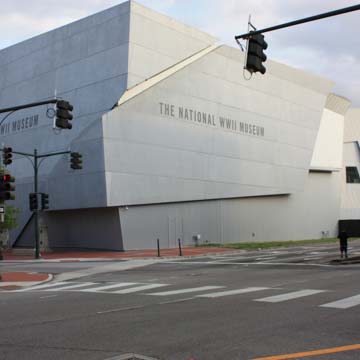The National World War II Museum began as and grew from the D-Day Museum that was established to honor American contributions to the D-Day invasion of June 1944 in World War II. New Orleans was proposed as its site through the advocacy of local historian Stephen E. Ambrose (1936–2002) and others in recognition of the crucial role the city played in the event. Landing craft employed in the invasion of France were developed and constructed in New Orleans by Andrew Higgins and were first tested on Lake Pontchartrain. Owner of a lumber export company, a fleet of ships, and a shipbuilding and repair operation, Higgins had developed before the war a highly maneuverable vessel with a shallow draft to move cypress logs out of the swamps. These boats also proved ideal for oystermen, fur trappers, and oil exploration crews in Louisiana who needed shallow-draft boats. During World War II, Higgins adapted the vessel for amphibious landing operations. The D-Day Museum was housed in a former brewery built in 1888 to house the Weckerling Brewing Company.
The former brewery is an important building, a reminder of the industrial nature of this area in the late nineteenth century and of the brewing industry (see OR189), the latter significant in the history of the city’s large German American population. Fitzner designed several breweries (all demolished) in the city.
For the first addition (2000) to the historic five-story brick structure, Lyons and Hudson repeated the structure’s height and its industrial character, but designed a facade of tinted glass outlined by an exposed truss, giving the impression of an airplane hangar. Set at an angle, the glass wall draws pedestrians to the entrance, showcases some of the exhibits, and gives the building a contemporary appearance.
The museum’s focus from a single event to the entirety of World War II and from matériel to human stories has expanded its physical presence to cover four city blocks and accommodate its growing attractions and international popularity. Among the recent additions is the U.S. Freedom Pavilion, a glass and concrete abstractly shaped structure that contains vintage aircraft, tanks, and other equipment and can be used as an event space. Exhibits in other pavilions focus on the many campaigns of the war, the people involved, and the conflict’s aftermath, including the Marshall Plan. The museum also includes a restaurant and a theater. A triangular steel and fiberglass canopy hovers 150 feet above the complex, and further additions are planned, including a central parade ground for ceremonies.















